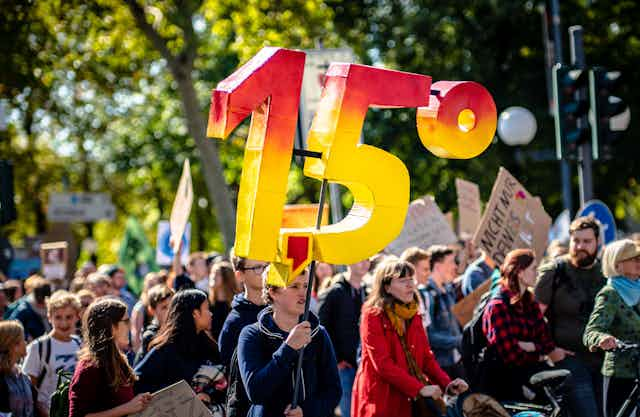On the eve of the Paris Agreement’s fifth anniversary, a global summit will convene to reaffirm ambition to limit warming to 1.5°C above pre-industrial levels. But global temperatures have already increased by nearly 1.2°C, and continue to rise at around 0.2°C per decade. That 1.5°C threshold is getting uncomfortably close, and scientists fear crossing it could trigger even more extreme weather and push threatened ecosystems close to collapse.
The good news is that the future is still ours to define. In a new study, my colleagues and I showed that making hard and fast emission cuts now to help each country reach net-zero emissions around 2050 could actually slow down the rate of global warming over the next 20 years.
This will not only keep the world on track to meet the Paris Agreement’s 1.5°C temperature goal, but will also give countries the necessary breathing space to prepare for the impacts that rising temperatures will bring.
Warming in the next few decades
Climate change is still often framed as a future threat. But its impacts – heatwaves, wildfires, extreme rainfall and flooding – already affect hundreds of millions of people around the globe. It doesn’t help that scientists have so far struggled to say with any certainty whether cutting emissions now will make a tangible difference to global temperatures before 2050.
Because the climate varies naturally from year to year, so does the speed of global warming. This has made it difficult to identify how climate action might make a difference on the relatively short timescales on which we devise policies, implement plans, and live our lives. We wanted to investigate whether we could untangle human influence on the climate from natural variability, and, if so, what difference hard and fast climate action might make.
In a report published in December 2019, we explored whether emissions reductions could influence warming rates on the relatively short timescales of nationally determined contributions (NDCs) – targets each country makes under the Paris Agreement to lower emissions between 2020 and 2030. We found that strong and immediate emissions cuts could make a larger difference to warming rates in the next few decades than we had originally expected, spurring us to investigate further.
How emission cuts affect the climate
Temperatures will continue to rise as long as we pump greenhouse gases, carbon dioxide in particular, into the atmosphere. But scientists have paid less attention to how fast these emissions will cause temperatures to rise. This is an important question because the faster the warming, the less time we have to plan for and adapt to higher temperatures.
It’s only after emissions have been declining for a while that the rate at which the planet is warming will noticeably decrease. From now until 2050 is a relatively short time in climatic terms, and natural variability makes it difficult to predict the short-term effects of applying the brakes on warming. If we can’t see the immediate benefits of emissions cuts, it makes it harder to pressure governments to take short-term action, which could disrupt the lives of voters.

To overcome this problem, we developed a new approach. We looked at thousands of temperature projections made by different climate models and added the effect of natural climate variability by using measurements from the real world. This allowed us to explore a broad range of potential futures and see what effect emissions cuts would have in each of them on the speed of global warming over the next two decades.
Looking at various emissions scenarios – ranging from a worst-case outcome where fossil fuel use increases sharply to one where warming stays within 1.5°C – showed how the choices we make now can either slow down or accelerate global warming.
The motivation to act now
The good news is that warming rates will fall substantially over the next 20 years if we get on course to reduce global emissions to net-zero by mid-century, in line with the Paris Agreement’s 1.5°C target. In fact, the risk of experiencing extreme warming rates that are stronger than anything previously seen would be 13 times lower with rapid and deep emissions cuts, compared to a future where the world doesn’t reduce emissions and continues to rely heavily on fossil fuels. This fossil-fuelled future could see temperatures rise by up to 1°C-1.5°C further in just the next 20 years.
In short, it’s not only future generations that will feel the benefits of rapid and deep cuts in emissions. Taking action now will greatly reduce the risk of global warming rapidly accelerating in the next few decades, giving us a greater chance to avoid the severe impacts that faster and more extreme temperature changes could bring, as well as getting us closer to limiting warming in the longer term.
In the run-up to the COP26 climate negotiations in Glasgow in November 2021, governments across the world are submitting their updated NDCs, outlining their plans to reduce greenhouse gas emissions. At the same time, they’re investing in COVID-19 economic recovery packages. Our work shows that there is an unmissable opportunity here to slow down global warming and build a world that’s more resilient.

